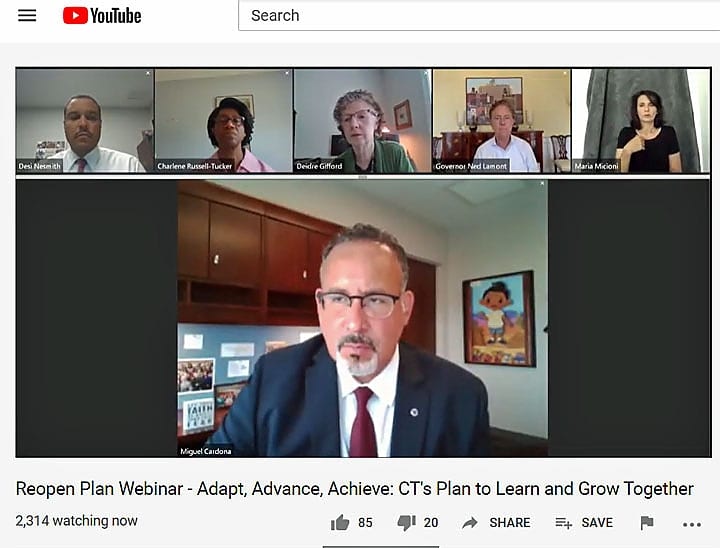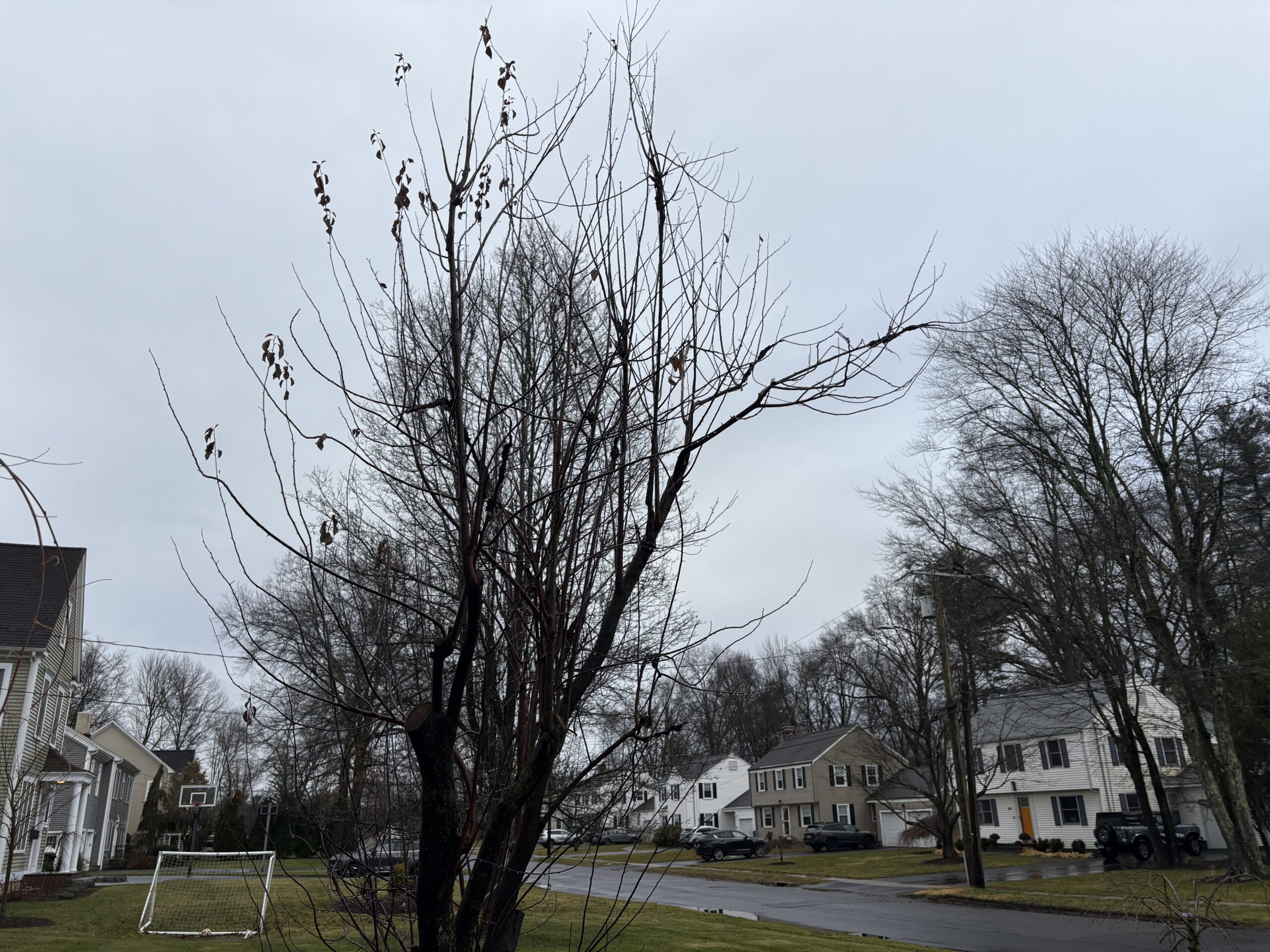Officials Try to Ease Parents’ Minds about Sending Kids to School

Audio By Carbonatix

Education Commissioner Miguel Cardona speaks at a webinar Thursday. Image courtesy of CTNewsJunkie.com
West Hartford Superintendent Tom Moore has asked families to respond to a survey by July 17 so that planning can move forward for the district.
By Christine Stuart, CTNewsJunkie.com
West Hartford-specific information provided by Ronni Newton, We-Ha.com
Connecticut officials tried to tackle as many questions as they could Thursday to put parents’ minds at ease about Connecticut’s school reopening plan for the fall.
“We all want children back for so many reasons,” Education Commissioner Miguel Cardona said at a webinar attended by parents and teachers.
Cardona said there is no “playbook” for any of them to reference, but they believe it’s best for children to return to school as safely as possible in the fall.
“There’s nothing in my mind that replaces the classroom as long as we can do that safely,” Gov. Ned Lamont said.
The question of how to open schools erupted this week when President Donald Trump criticized the federal government’s own guidance and then threatened to withhold funding for schools that don’t fully reopen.
“I sort of resent some of the language I hear coming out of the White House right now forcing people back and threatening,” Lamont said.
Lamont said Connecticut is in a position to do this safely because of its low infection rate.
He said he knows there are going to be questions about cost, but that’s why the state wanted to get its guidance out early to allow districts to prepare for what they may need.
West Hartford Superintendent of Schools Tom Moore, who also favors getting children back into the classroom, reached out to families last week with some preliminary information about what that may look like in West Hartford this fall. He has requested that families complete an online “Learning Intentions Survey” by July 17.
Moore said it will be critical to know from families if their children will be attending in-person school so that class lists can be developed and the number of teachers needed can be properly determined.
The state has earmarked $111 million of the federal CARES Act funding it received for school districts.
Officials were questioned about how they plan to safely reopen schools; a large part of the plan is called “cohorting.”
Acting Department of Public Health Commissioner Deidre Gifford said that means keeping small groups of kids together and not mixing them with other small groups.
“It limits the exposure of individuals in that cohort to other individuals,” Gifford said.
Doing so might mean that if there is a positive case of COVID-19, a single cohort would have to quarantine for 14 days, but not the entire school.
“It also makes it easier to know if someone does get ill, who they’ve been in contact with,” she said.
Cardona said he knows students have different social groups or teams that they are engaging with after-hours that the schools have no control over, but a “combination of mitigation strategies is the best.”
Another mitigation strategy will be ensuring everyone wears a mask.
Any student or staff member who does not have a mask will be given a mask by school administrators.
Cardona said handing out a mask will be like “handing out a pencil when a student didn’t have them.” He said it’s something schools are familiar with doing for other supplies.
The plan under development for West Hartford would include cohorting for the elementary schools and keeping middle school students with their teams. Block scheduling is a likely scenario for middle and high school students to reduce the number of transitions in the hallways between classes.
Parents participating in the webinar also wanted to know why the state decided against regular COVID testing and temperature checks.
Gifford, who is a physician, said temperature checks are not a “sensitive” way to pick up individuals who may be asymptomatic and spreading the disease. She said it also causes a back-up at the entrance to the schools.
Instead, they will be educating parents and staff about “symptom awareness.”
As far as testing is concerned, “It tells you about a moment in time,” Gifford said. She said testing doesn’t “necessarily tell you whether they might develop that and become symptomatic tomorrow.”
Gifford said DPH is working on a notification policy for how to inform parents of an infection in a school. She said they have to take privacy concerns into consideration, but the need to know to prevent the spread of the coronavirus is the number one concern.
While the state is allowing student to return full-time in the fall, many parents have expressed concern about sending their children to the school building. Many districts are surveying their parents and students right now to see how many are willing to come back in the fall.
Schools also will have to provide an alternative for students who don’t want to return to the classroom.
The experiment with distance learning that parents and students were forced into at the end of March varied widely based on the age and ability of the student, internet access, and a parent’s ability to help.
Deputy Commissioner Desi Nesmith said the education department knows there’s a need for computers in some districts and they are asking the local school districts to prioritize funding to buy additional laptops.
But because of the known barriers to internet access, there won’t be a “one-size-fits-all” solution.
“We’re going to have to work with districts on a menu of options based around their need,” Nesmith said.
A coalition of parents, attorneys, educational advocates and community providers issued a statement later Thursday calling for educational equity and accountability.
“While some students had regular access to educators, including access to live instruction, many others languished with no computer access or teacher support, and no meaningful access to education,” the group said in a statement. “The state must have a clear strategic plan of action to address device and internet access as basic need and a public structure for reporting on distribution and connectivity efforts.”
The group, which was led by the Office of the Child Advocate, also said the state “must develop an equity and accountability task force to support reopening and student participation, that includes a specific mandate to address systemic racism’s impact on education and lost opportunity for children with disabilities. The equity and accountability task-force must include parents and parent advocates/representatives, youth, community providers, and educators, as well as legislators and state officials.”
The state’s two largest teachers’ unions expressed frustration when the initial 50-page state guidance was released in June. Thursday, the president of the Connecticut Education Association said it boils down to a matter of resources and details.
“The health and safety of our students, educators, and staff and the funding necessary for COVID-related expenses are among the top priorities for CEA and our members,” Jeff Leake, president of the CEA, said. “Having the right resources to protect the health of students and educators is critical. We continue to be concerned about transportation issues and meeting the needs of high-risk students and educators and students with special needs.”
The entire webinar can be seen below.
Republished with permission from CTNewsJunkie.com, all rights reserved.
Like what you see here? Click here to subscribe to We-Ha’s newsletter so you’ll always be in the know about what’s happening in West Hartford! Click the blue button below to become a supporter of We-Ha.com and our efforts to continue producing quality journalism.



